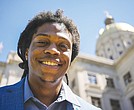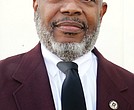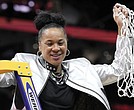Personality: Keith W. Hicks
Spotlight on the 2015 Astorian of the Year
12/25/2015, 12:50 a.m.
“To inspire men to a higher moral, intellectual, civic and social standing” through activities that build a better community and promote racial equality.
That has been the mission of the Astoria Beneficial Club since its founding 114 years ago.
In recent decades, the men’s organization has played a key role in commissioning statues in Jackson Ward to Richmond native Bill “Bojangles” Robinson, a renowned tap dancer, and on Brown’s Island of The Headsman, which commemorates the brave African-American boatmen who contributed to the commercial development along the James River from the 1700s to the mid-1800s.
The 112 members of the civic-minded group consider Keith Hicks to be a sterling example of commitment to the organization’s mission.
They showed their high regard for him by selecting Mr. Hicks as the 2015 Astorian of the Year.
He was presented the award Nov. 15 in a ceremony at The Grace Center, 1302 Victor St., in North Side.
“The award recognizes a person who has strong religious values, intellectual growth, continuous civic and social responsibility and a resilient commitment to the Astoria’s vision and mission,” according to the club.
“It was breathtaking and I was overwhelmed with joy and excitement,” Mr. Hicks says of winning the award.
“I feel honored, overjoyed and grateful for such recognition of my work,” he adds. “It gives me inspiration to continue to assist with the long-term growth strategy of the organization. This award means the world to me.”
Mr. Hicks has been a member of the club for seven years and is Membership Committee chairman. “It is my duty to prepare a program that is inviting and allows a platform for new potential members to interact with existing members,” he states. “This particular membership drive brought in more than 10 new members to the organization.”
He credits his parents, George and Mary Sue Hicks, for teaching him how to be successful in life.
“They both struggled and worked hard to provide a good quality of life for me and my sister,” Mr. Hicks says. “They both worked two jobs when needed and provided a clear window for us to look through so that we could dream and become what God intended us to be.
“The best thing my parents ever taught me is that the world owes you nothing,” he adds. “Hard work and presenting yourself in a distinguished professional manner at all times are the key to success.”
Here’s a look at this week’s Personality, Keith W. Hicks:
Date and place of birth: Jan. 3 in Richmond.
Residence: Historic Battery Park.
Education: Bachelor’s degree, Averett University; master’s degree, University of Phoenix; also studied at Virginia State University.
Family: Wife, Lisa Hicks; son, Devin, 21; daughter, Kelli, 15.
Occupation: Business analyst with Thompson Technologies as a contractor for SunTrust Bank.
Club membership requirement: To qualify for regular membership, an individual shall be a registered voter, and be between the ages of 18 and 50. He also must have two members in good financial standing to vouch for him.
To qualify for associate membership, an individual shall be a registered voter, and age 51 or older. He also must have two members in good financial standing to vouch for him.
How Astoria membership has changed from founding to now: Members in the past were not afforded the right to vote or freedom to speak out vocally by way of social media, television and radio. The founders used foot soldiers to galvanize its members then, while today’s members are galvanized through social media, television and radio.
Plan for recruiting new members: We recruit members through our annual membership drive night and recommendations from current members.
Member profile: United States citizens that are registered voters and have a passion to help others.
Average age of club members: 60.
How it feels to continue the Astoria legacy: It feels as if I am charged with the responsibility of keeping the torch lit with the fire of faith, hope and love for our fellow man.
Astoria’s No. 1 success: Astoria is proud of its 114-year history overflowing with its contributions that help make the Richmond community a city of hope and high expectations for all. Club’s top project now: To continue to build its PALS program, Parental Assistance Leadership Service. PALS provides mentors to Fairfield Elementary School in the Church Hill community. PALS recognizes that a solid citizenship starts when children are young and surrounded by positive role models. Astoria PALS members volunteer as mentors, hall monitors, lunch buddies, chaperones and room fathers.
Top Astoria challenge: To continue to stay innovative and have a significant impact on the ever-changing climate that entrenches our culture. We also will continue to fight the good fight of faith and engage in responsible dialogue with our community leaders.
Why I am excited about this organization: I am excited about the Astoria Beneficial Club because it gives me a chance to dialogue with seasoned members who were part of the civil rights struggle and know first hand how difficult it was to fight for equal pay for teachers, voters rights and to promote fair and equitable hiring practices for all. These are true stories that I hear, not something that you just read in a history book. These men were on the ground, imbedded in the struggle and provide me with the fuel to keep keeping on.
Role of club in politics: Astoria is not a political organization.
Significance of the Bill “Bojangles” Robinson statue: During a club meeting in April 1972, Carroll Anderson presented a proposal to The Astoria Beneficial Club to erect a statue to Bill “Bojangles” Robinson, with the purpose being “to serve as an inspiration to coming generations of young Richmonders that they, too, may make a meaningful contribution.”
Bill “Bojangles” Robinson was born in Richmond on May 25, 1878, at 915 N. 3rd St. He spent his early years in the market area shelling peas and sidewalk dancing. His dancing abilities carried him to the top of the entertainment world and on to become acclaimed as “The King of Tap Dancers.” He donated the first traffic control light north of Broad Street at Adams and Leigh Streets for the safety of the students of Armstrong High School.
Significance of the Headsman statue on Brown’s Island: These African-American bateau men were highly skilled laborers and masters of traveling through turbulent waters along the James River and traveled as far as Ohio and Pennsylvania. Their craft was equivalent to modern day airline pilots. These men bought their own freedom and that for their family members and settled in Richmond’s Jackson Ward while providing financial freedom to local communities. Former Richmond Mayor Walter Kenney, former Mayor and Sen. Henry L. Marsh III, representatives of Richmond City Council, Richmond Renaissance, former Deputy City Manager Jerry Johnson and Mrs. Grace Jackson were instrumental in raising funds for the statue.
What I do to unwind: Eat sherbet and read books on leadership.
Perfect day: When I come home and my entire family is home and we eat dinner together.
Perfect evening: When my wife and I are in the kitchen cooking a meal together.
Quality I value most in other people: Transparency.
Best late-night snack: Grilled cheese sandwich.
Four words that best describe me: Resilient, risk-taker, visionary and compassionate.
The book that influenced me the most: “The Audacity of Hope” by President Obama. Book I’m presently reading: “Martin Luther King, Jr. On Leadership: Inspiration & Wisdom for Challenging Times” by Donald T. Phillips.
If I’ve learned one thing, it is: Never judge a book by its cover.
My next goal: To become a motivational speaker.







